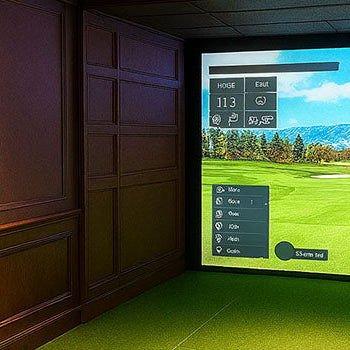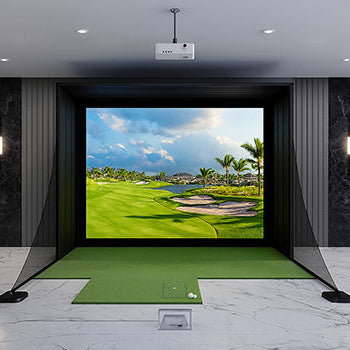Tired of tee times getting cancelled because the weather has other plans? A Golf Simulator lets you play iconic courses from the comfort of your own home, no sunscreen or waterproofs required.
Short answer: It's an indoor setup that tracks your swing, crunches the numbers, and shows your shot flying across a virtual course.
Why keep reading? We’re breaking down how it works, what it measures, who uses it, and why it’s more than just a fancy gadget.

What is a Golf Simulator? A Simple Definition
Bringing the Golf Course Indoors with Technology
Imagine turning your spare room or garage into St Andrews or Pebble Beach. That’s basically what a golf simulator does. It recreates the golf experience indoors using real clubs, real (or foam) balls, and clever tech that makes you feel like you're standing on a real fairway.
Instead of watching your ball disappear into the bushes, you watch it soar across a screen. And yes, it's surprisingly satisfying.
More Than a Game: A Tool for Practice, Entertainment, and Improvement
Sure, it's fun. But a golf simulator isn’t just a grown-up toy. It's a training partner, a party game, and a swing coach all rolled into one.
You can work on your short game before breakfast or host a mini Ryder Cup with friends on a Friday night. Either way, you’re improving without stepping outside.
The Core Concept: Tracking Your Shot and Simulating its Flight
Here’s the magic: you swing, the simulator tracks your shot using sensors or cameras, and software turns that into a visual on screen.
You get instant feedback, ball speed, spin rate, launch angle, even how open or closed your clubface was.
It’s like having a golf coach and a TV sports analyst right there with you, every swing.
How Does a Golf Simulator Work? The Three-Step Process
Step 1: The Shot (Hitting a Real Ball with Your Clubs)
You tee up a ball, real or foam, on a hitting mat, grab your club, and swing like you would on the range.
The feel is the same, but the ball doesn’t go flying into the neighbour’s fence (which your neighbours will appreciate).
Yes, most simulators let you hit real balls, making the practice much more authentic.
Step 2: Data Capture (The Launch Monitor Measures Your Swing and Ball)
As you strike the ball, a launch monitor goes to work.
It tracks everything. Speed, spin, angle, path, and more. Depending on the system, this can involve radar tech, infrared sensors, or high-speed cameras.
Think of it like a Formula 1 pit crew, but for your golf swing.
Step 3: Virtual Flight (Software Renders the Shot onto a Screen)
Next, the simulator's brain (the software) kicks in.
It takes all that raw data and translates it into a shot that’s displayed on screen, complete with distance, trajectory, and spin.
One second you're swinging in your socks, the next you're watching your ball cut the corner on Augusta’s 13th. Not bad for a Wednesday night.

The Essential Components of a Golf Simulator Setup
The Heart: The Launch Monitor
This is where the data magic happens.
A launch monitor tracks your ball and club with crazy accuracy.
Affordable models use radar or sensors, while top-tier versions use ultra-high-speed cameras for detailed feedback.
If you want to improve your game, this is the bit that really matters.
The Brain: Simulation Software and Computer
Your PC or tablet runs the software that makes golf simulation feel real.
It doesn’t just show pretty courses, it also gives you in-depth analytics, replays, club comparisons, and even multiplayer modes.
Want to play a virtual match with someone in another country? You can.
The Hitting Zone: Golf Mat and Enclosure/Net
A durable hitting mat gives you the right surface feel, so you’re not tearing up your carpet.
Pair that with an enclosure or net to catch your shots safely.
It’s not just about accuracy, it’s about avoiding broken light fixtures, too.
The Visuals: Impact Screen and Projector
This is where the “wow” happens. The screen shows your shot, and the projector displays the course in vivid detail.
Some setups use TVs, but a wall-sized projection gives you the full immersive experience.
It’s the difference between watching golf and feeling like you’re playing it. Many golf simulators use this combo for max realism.
What Does a Golf Simulator Actually Measure?
Key Ball Data Metrics (Ball Speed, Spin Rate, Launch Angle)
Ball data is where improvement starts. The simulator tracks how fast the ball comes off your club, how much it spins, and how high it launches.
These numbers help you dial in distance, shape, and consistency, things that matter whether you’re aiming for the green or the leaderboard.
Key Club Data Metrics (Clubhead Speed, Angle of Attack, Club Path)
Club data goes deeper. It shows how you approached the ball, your face angle at impact, and even how your hands moved through the swing.
This is the stuff golf coaches obsess over, and now, you can too.
How This Data Translates to an Accurate Shot Shape
By combining ball and club data, the simulator builds a realistic flight path. If your shot curves left, it’s not guessing, it knows why.
That’s how indoor golf simulators feel so close to the real thing. Every shot tells a story, and you get the full breakdown.
Who Uses a Golf Simulator?
For the Home User: Year-Round Practice and Entertainment
If you're tired of losing months of practice to rain, cold, or dark evenings, a home setup is a game-changer.
You can swing in your slippers, test a new driver, or sneak in nine holes before dinner.
Indoor golf simulators make staying sharp simple and fun.
For the Golf Professional: Coaching, Data Analysis, and Club Fitting
Coaches use simulators to break down every detail of a student’s swing. Club fitters test shaft stiffness, lofts, and lie angles, all without leaving the studio.
It’s precision meets convenience, and it’s helping golfers level up faster than ever.
For Commercial Venues: Indoor Golf Bars and Entertainment Centres
Simulators are now popping up in bars, clubs, and retail spaces.
Why just grab a pint when you can grab a driver too?
Virtual golf has become a social event, not just a solo hobby.

Types of Golf Simulators: From Basic to Professional
Entry-Level Setups (Net, Mat, and Personal Launch Monitor)
Budget-friendly simulators start around £500.
You’ll get a net, mat, and a simple launch monitor, perfect for casual players or those with limited space.
It’s like a driving range in a box.
Mid-Range Home Simulators (Enclosure, Screen, and Projector)
Want the real feel without blowing your savings?
For around £3,000–£5,000, you can build a system with more accurate tracking, larger visual screens, and software that features multiple virtual courses.
These types of golf simulators are great for serious golfers who want the full experience at home.
High-End Commercial and Professional Systems (Advanced Cameras, Larger Spaces)
At £10,000 and up, you’re entering pro territory.
These simulators come with high-speed cameras, immersive course visuals, advanced swing analysis, and full enclosures.
They're built for teaching pros, club fitters, and luxury golf lounges, and they don’t cut corners.









